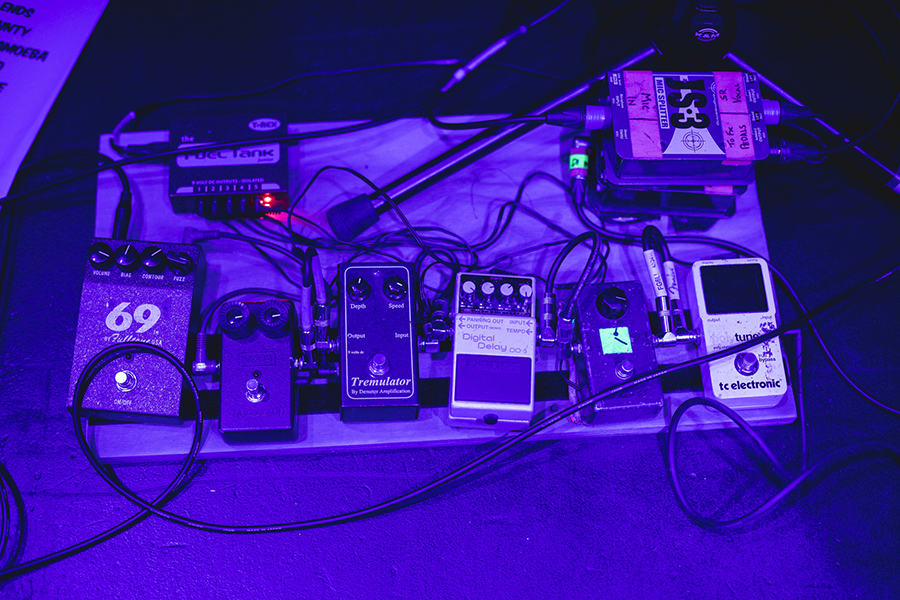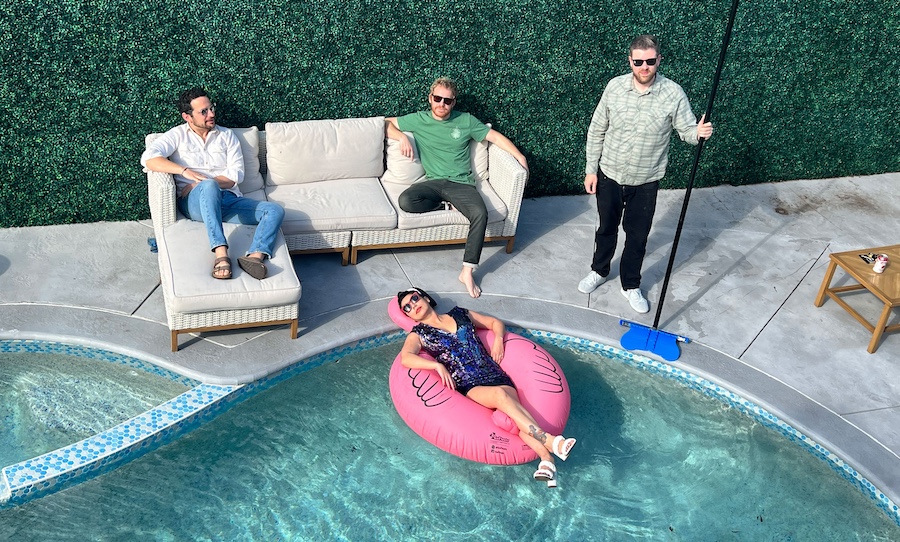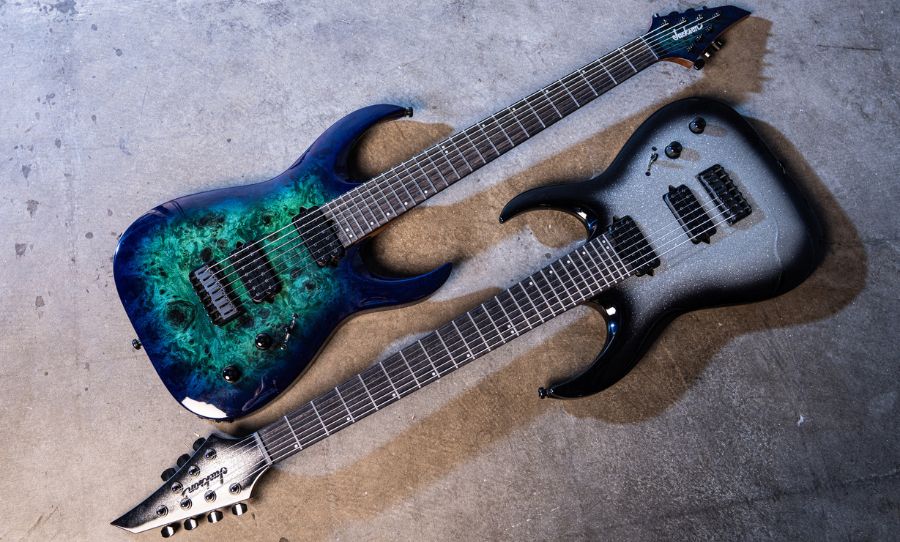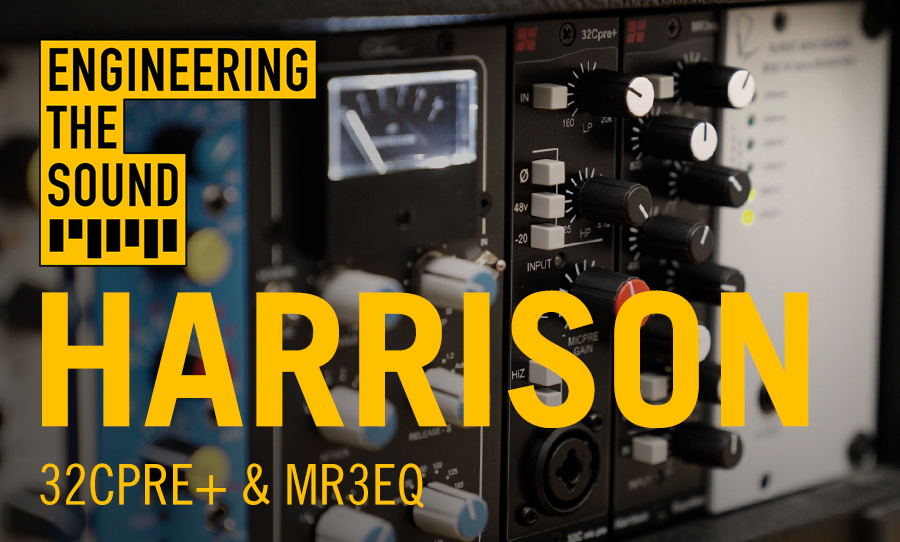A couple of weeks back in June, Red Bull Music returned to Hobart as part of Dark Mofo for the fourth year in a row where they hosted a massive party featuring Jagwar Ma alongside Tornado Wallace, NO ZU and Lauren Hansom.
An immersive, all-consuming event, the night featured mind-bending light installations artist from Jim Warrior alongside the band, transforming the stage into an audio-visual banquet. As usual, Jagwar Ma put on a show of epic proportions, and we were pretty stoked to be given some amazing snaps of their stage setup.
To find out a little more about what gear they’re using live, we had a chat with Jono Ma and Gabriel Winterfield from the band.
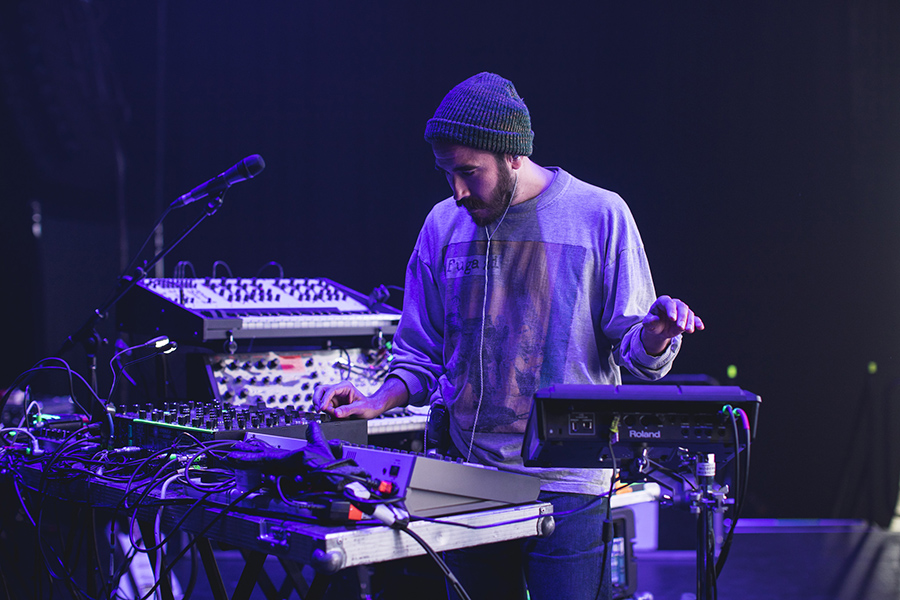
We had a chat with Jono Ma and Gab Winterfield from Jagwar MA about the gear they were using at their epic recent performance at Dark Mofo.
Jono Ma
HAPPY: This is a huge rig. How long have you been touring with this setup?
JONO: Well, the rig has been huge since day one. What can I say… I like technology and I don’t like making things simple for myself. The rig has consistently grown over the years… an additional fx pedal here, a synth there, a new drum machine or two.
But this setup for Dark Mofo was the biggest yet with the addition of a custom built Funktion One Mixer allowing me to sub mix everything before front of house. And also we added a giant modular video synth to allow realtime generative video graphics controlled by my audio output.
HAPPY: Is there a ‘centrepiece’ in your mind? I’m struggling to get my head around how the puzzle fits together.
JONO: Well, the submixer is now the centre piece I guess. Everything runs through that before it goes to front of house. It allows me to control and glue everything together in the way that I hear it. It also allows me to hype up sections with filters and fx in the way that I would if I were DJing. All the clocking comes from Ableton though so in a way that’s actually the “brain” of the setup… but I was always joking about how having a real TR-909 or TR-808 (a 909 in this case) gives me this extra confidence for a show… a bit like if you had Lionel Messi on your team… you just know everything is under control.
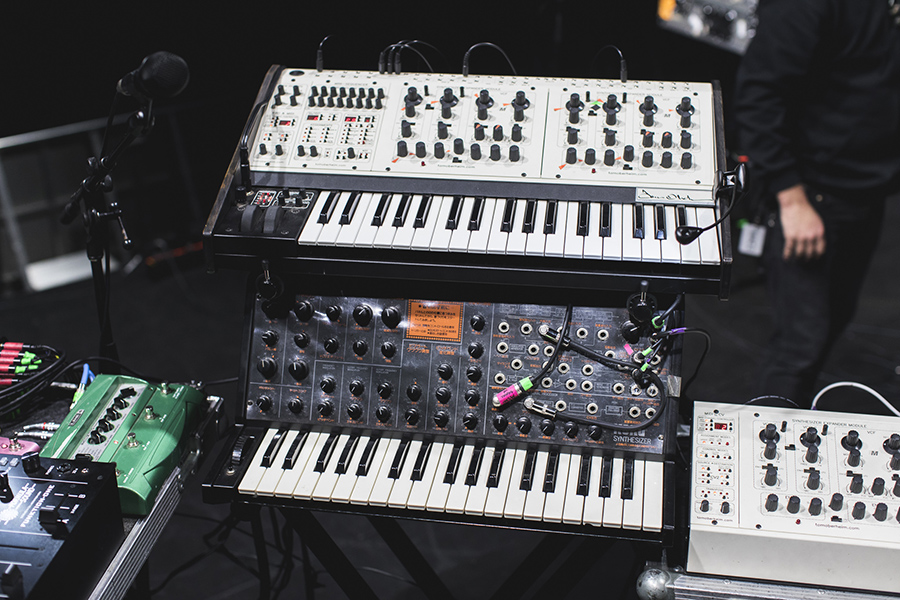
HAPPY: I saw a while back your MS-20 got trashed on a flight, it almost made me cry. Did you get it repaired or did you manage to track down another vintage model?
JONO: Oh man, that was WILD. I’d had that thing since back in the Valentinos… so over 10 years. It was my first mono synth. I couldn’t believe how destroyed it was even in a heavy duty flight case. Even the ground staff at Atlanta airport gasped when they saw it. The cold thing was the ground baggage handlers that did it behind the curtain just sent it out on the belt as though nothing had happened. That’s some cold as shit.
So as it was a week before Coachella and we were touring all through that week down the bible belt in the Deep South, it was difficult to track down an original Rev.1 Filter MS-20. Even finding the new MS-20 Mini reissue was tough. There wasn’t time to ship one out from Japan and considering the smashed synth had a circuit board split into 3 pieces, repairing it was out of the question.
I’d given up on the idea of finding one when just by chance we got in contact with this kid in Austin Texas who claimed to have an Original Rev.1 Fliter MS-20 for sale. We immediately drove to his place in the outskirts of Texas and lo and behold, he had the exact same model of MS20 that I had and it sounded just like mine (I’ve found they all sound quite different). He had this strange garage setup with a kit and a makeshift studio and then he asked if he could play us his music… I had that awkward fear that it was going to be some gross song that we’d have to pretend to like and compliment profusely and a few bars into the track I felt the room relax and we all agreed his music was DOPE hahaha. He was making this strange kinda Beck style indie hip-hop stuff… very cool… I wish I could recall his name!
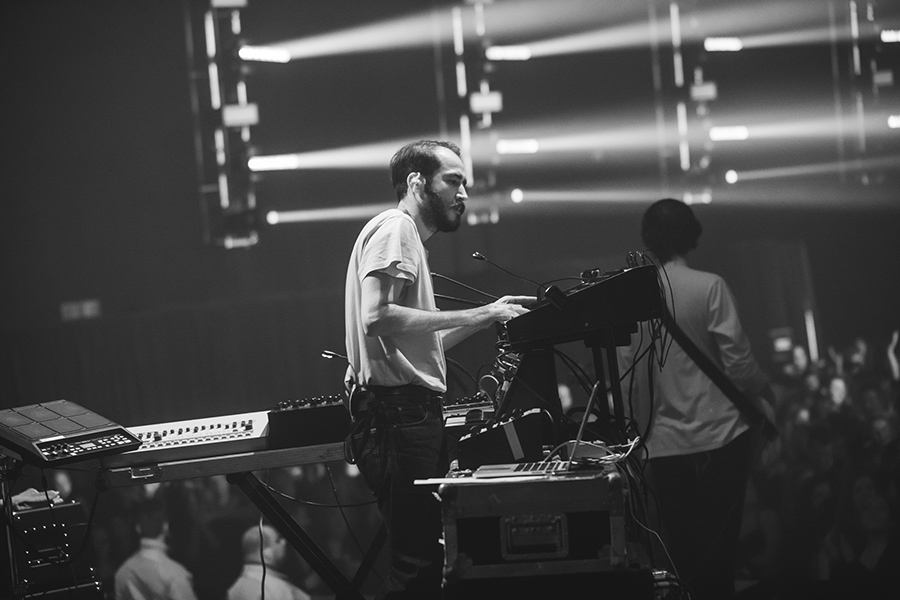
HAPPY: I’ve never played the Two Voice but playing a lead while a sequence is running sounds like a dream. Was this a big selling point?
JONO: Oh man, the Two Voice is something else. I’ve actually got six voices all up! I bought an old 70s Two Voice first and fell in love with the Oberheim SEM sound. Then I got the new Two Voice Pro (reissue) to tour with and then I’ve added two extra SEM modules, so I can hook them all up and make a six Voice. Jamie XX has an eight voice tho, so he wins.
HAPPY: A lot of your music is sequence-driven. Are you programming these any on the fly or mostly relying on queues?
JONO: Live, the sequences are triggered by Ableton MIDI information. It would be ludicrous programming these on the fly for a Jagwar Ma show when Gab and Jack and I all have to conform to structures and arrangements. I don’t really see a benefit of programming sequences on the fly. I’d rather have dope sequences prepared and then TWEAK them live.
HAPPY: Where do these sequences/ARPs fit into your recording? Are they ever a starting point?
JONO: Sometimes they’re an afterthought, like the arpeggio in Come Save Me for example. That was the last thing added to the track after it had been “finished” for months. O B 1, on the other hand, began with that arpeggio and then I built a beat around it and then Gab reacted to that.

HAPPY: You’ve used a TR-808 in the studio but I think I see a 909 on the live rig. How do these two differ for you?
JONO: Actually I used to tour with the TR-808 at the beginning but it was getting damaged and I figured, this is actually irresponsible, someone is going to report me to the authorities if I keep this up… So I switched to the TR-8 which I actually really liked because it had faders as opposed to little tiny knobs (as on the regional TR-808 and 909) but the TR-8 just didn’t sit in the mix the same way the 808 did. I only recently found a TR-909 in a strange outback town near Toowoomba and had to get it. I’ve recently been loving having the 909 so I decided to integrate that just for Dark Mofo… special occasions you see.
I see the main difference being a technical one that effects the essence of the machines. The TR-808 is all electronic oscillators and noise capacitors, in other words, everything is created from an electronic source and shaped into a drum sound. The TR-909 on the other hand has a combination of electronic source sounds, and 12-bit samples, resulting in a slightly more ‘live’ sounding drum machine. The 808 kinda cuts through and has this unrivalled electronic, futuristic precision whereas the 909 has this almost dusty, crunchy thunderous quality that adds a strangely live energy to the mix. To be honest, if I didn’t think I’d be reported for vintage gear abuse I’d take both on the road with me.
HAPPY: What’s the piece of gear you think you’ve gotten the most value out of?
JONO: Hmn damn, that’s a good question. Look, the TR-808 changed my life. When I worked out how to sync it to my DAW and how to then trigger all my synth sequences off the 808’s sequencer and multiple outputs, it brought my whole studio to life and got all the machines talking, breathing and grooving together….
… but if I’m honest, the laptop and Ableton wins. Ableton turned my laptop into an instrument and although I’m a total analog gear junkie, if I could only have one piece of kit it would be that.
Gab Winterfield
HAPPY: Your pedal chain is super interesting – it’s almost backwards with fuzz and compression last, delay and modulation first). Why is that?
GAB: It makes more sense to me to sum your final sound through compression as a way of levelling all the different fx. Compressing a dry guitar input would only serve to boost the low sounds of a dry tone.
HAPPY: What’s the main live guitar you use live at the moment? I’ve seen you use Jags, Strats, Mustangs – you’re obviously fond of Fenders?
GAB: I would play anything on stage, I’m not really that bothered, but I think for sentimental reasons I’m always drawn to Fender (my dad has an emerald green Strat). Now I have a few Fenders of my own so I switch them up. Recently I’ve been using my Stratocaster a lot, its a 1965 , not all original, but it sounds and plays amazingly.
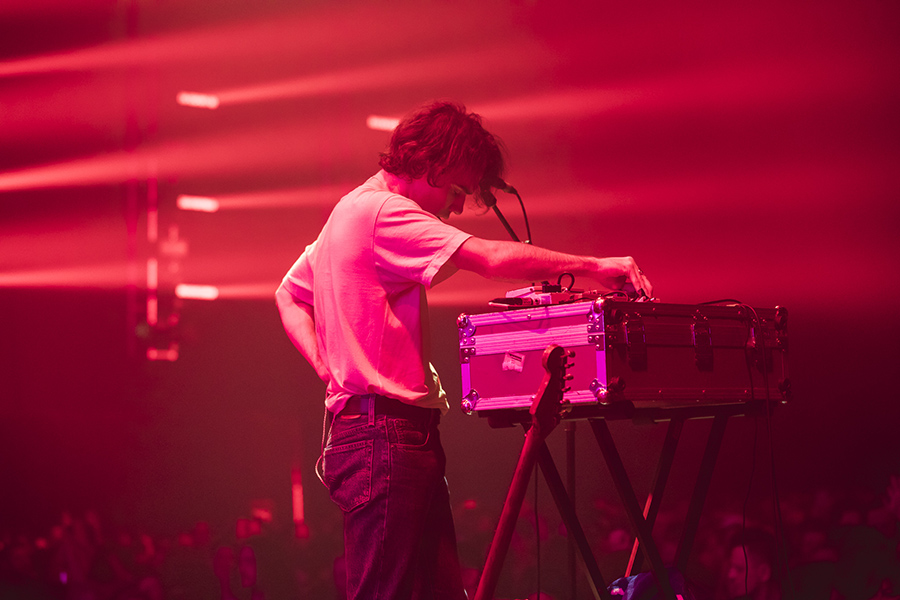
HAPPY: I see a couple of DI boxes on your pedalboard. I’m assuming these are for running your vocals through guitar pedals? Tell us a bit about your vocal chain.
GAB: The vocals are split with a DI so then I have a wet/dry signal, I run a delay and two loopers so that I can harmonise on the fly, be in control of my own delays.
This article originally appeared on Enmore Audio.

